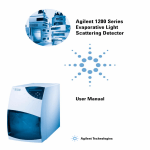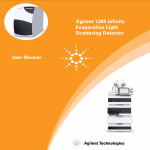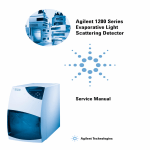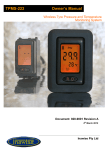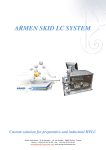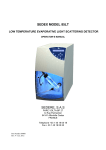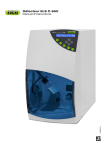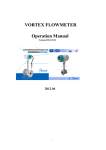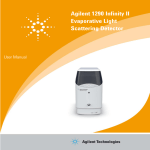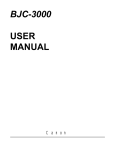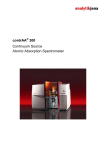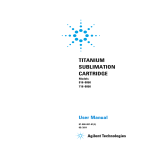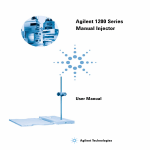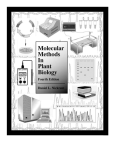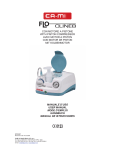Download Agilent 1200 Series Evaporative Light Scattering Detector
Transcript
Agilent 1200 Series Evaporative Light Scattering Detector User Manual Agilent Technologies Notices © Agilent Technologies, Inc. 2008 Warranty No part of this manual may be reproduced in any form or by any means (including electronic storage and retrieval or translation into a foreign language) without prior agreement and written consent from Agilent Technologies, Inc. as governed by United States and international copyright laws. The material contained in this document is provided “as is,” and is subject to being changed, without notice, in future editions. Further, to the maximum extent permitted by applicable law, Agilent disclaims all warranties, either express or implied, with regard to this manual and any information contained herein, including but not limited to the implied warranties of merchantability and fitness for a particular purpose. Agilent shall not be liable for errors or for incidental or consequential damages in connection with the furnishing, use, or performance of this document or of any information contained herein. Should Agilent and the user have a separate written agreement with warranty terms covering the material in this document that conflict with these terms, the warranty terms in the separate agreement shall control. Manual Part Number G4218-90000 This product is intended for research use only. Not for use in diagnostic procedures. Edition 01/2008 Printed in Germany Agilent Technologies, Inc. Hewlett-Packard-Strasse 8 76337 Waldbronn Microsoft ® is a U.S. registered trademark of Microsoft Corporation. Parafilm™ is a trademark of American National Can Co. Teflon™ is a trademark of E.I. Dupont de Nemours, Inc. Tygon™ is a trademark of the Norton Corporation defined in FAR 52.227-19(c)(1-2) (June 1987). U.S. Government users will receive no greater than Limited Rights as defined in FAR 52.227-14 (June 1987) or DFAR 252.227-7015 (b)(2) (November 1995), as applicable in any technical data. Safety Notices CAUTION A CAUTION notice denotes a hazard. It calls attention to an operating procedure, practice, or the like that, if not correctly performed or adhered to, could result in damage to the product or loss of important data. Do not proceed beyond a CAUTION notice until the indicated conditions are fully understood and met. Technology Licenses The hardware and/or software described in this document are furnished under a license and may be used or copied only in accordance with the terms of such license. Restricted Rights Legend If software is for use in the performance of a U.S. Government prime contract or subcontract, Software is delivered and licensed as “Commercial computer software” as defined in DFAR 252.227-7014 (June 1995), or as a “commercial item” as defined in FAR 2.101(a) or as “Restricted computer software” as defined in FAR 52.227-19 (June 1987) or any equivalent agency regulation or contract clause. Use, duplication or disclosure of Software is subject to Agilent Technologies’ standard commercial license terms, and non-DOD Departments and Agencies of the U.S. Government will receive no greater than Restricted Rights as WA R N I N G A WARNING notice denotes a hazard. It calls attention to an operating procedure, practice, or the like that, if not correctly performed or adhered to, could result in personal injury or death. Do not proceed beyond a WARNING notice until the indicated conditions are fully understood and met. Agilent 1200 ELSD User Manual In This Guide... This manual is designed to describe the installation; operation, maintenance and basic troubleshooting of the G4218A Agilent Evaporative Light Scattering Detector. It includes: 1 Introduction 2 Installation of the Detector This chapterdescribes suitable laboratory conditions for the detector and includes information about interfacing the detector to other devices. 3 Start-Up Procedure This chapter describes the role of the various controls and displays on the detector. In addition, this chapter discusses a number of activities to prepare the unit for routine data collection. 4 Operating the System This chapter describes how to operate the Low Temperature Evaporative Light Scattering Detector. It includes information about starting the unit on a routine basis, collecting data and shutting down the unit. 5 Maintenance and Troubleshooting This chapter describes a series of activities that should be performed on a periodic basis to ensure maximum performance. In addition, this chapter includes a protocol that can be used to determine the cause of problems that are observed with the instrument. Agilent 1200 ELSD User Manual 3 6 Specifications 7 Spare Parts List 8 Electrical connections Appendix A Appendix This chapter contains safety information. 4 Agilent 1200 ELSD User Manual Contents 1 Introduction 9 The Low Temperature Evaporative Light Scattering Detector Principle of Operation 12 Nebulization 14 Evaporation of the Solvent Detection 17 2 Installation of the Detector 17 19 Lifting and Carrying the System Unpacking the System 10 21 22 Laboratory Requirements 23 Power Requirements 23 Gas Requirements 23 Exhaust venting and drain requirements 24 Location of the Detector in the Laboratory 24 Environmental Conditions 25 Installation of the Unit 26 Gas Supply 26 Vent the Exhaust Line to a Fume Hood 28 Electrical Connections 28 Installing the nebulizer and nebulization chamber assembly Connecting the Siphon Overflow 32 Connecting the Nebulization Gas to the Nebulizer 33 Connecting the Column 33 Powering Up the Unit 33 Agilent 1200 ELSD User Manual 29 5 Contents 3 Start-up Procedure 35 The Control Panel 36 The Digital Display 37 The User Interface 38 Installation Test Procedure 4 Operating the System 47 49 Preparing the System for Operation 50 Auto-zeroing the Detector 51 Manual Auto-zeroing of the Detector External Auto-zeroing of the Detector Routine Operation of the System 51 51 52 Optimizing Performance 53 Selecting the Optimum Temperature Optimizing the Mobile Phase 55 Sample Pre-Treatment 55 Column Treatment 56 Optimizing the Filter 56 53 Powering Down and Shutting Down the System 5 Maintenance and Troubleshooting Maintenance 60 General inspection 59 60 Troubleshooting 61 Basics of Troubleshooting 61 Initial Troubleshooting Activities 62 If there is no response from the system Perform the Noise Tests 63 Specific Detector Troubleshooting 64 Cleaning the Nebulizer 65 6 58 62 Agilent 1200 ELSD User Manual Contents Cleaning and Decontamination 67 Cleaning the Detector 67 Decontaminating the detector 67 Noise test procedures 69 Preliminary Activities 70 Electronic Noise Test 71 Background Noise (Stray Light) Test Solvent Noise Test 73 Column Noise Test 75 6 Specifications 7 Spare Parts List 8 Electrical connections A Appendix 77 79 83 87 Safety Information Solvent Information 88 91 Lithium Batteries Information Index 72 93 95 Agilent 1200 ELSD User Manual 7 Contents 8 Agilent 1200 ELSD User Manual Agilent 1200 Evaporative Light Scattering Detector User Manual 1 Introduction The Low Temperature Evaporative Light Scattering Detector 10 Principle of Operation 12 Agilent Technologies 9 1 Introduction The Low Temperature Evaporative Light Scattering Detector The Low Temperature Evaporative Light Scattering Detector The Agilent 1200 Series Evaporative Light Scattering Detector (Figure 1) is designed to detect compounds in the eluent from high performance liquid chromatography (HPLC), micro-HPLC, gel permeation chromatography (GPC) or counter current chromatography (CCC). It is capable of monitoring eluent flow rates from 5 µl/min to 5 ml/min. Evaporative light scattering detection is a universal technique which can detect any non-volatile analyte. Detection does not depend on the absorbtion of radiation and is not affected by the absorbtion characteristics of the solvent; thus solvents which absorb UV radiation can be used. Figure 1 10 The Agilent 1200 Series Evaporative Light Scattering Detector Agilent ELSD User Manual Introduction The Low Temperature Evaporative Light Scattering Detector 1 The detector is controlled via the keypad and digital display on the front panel. Alternatively, the system can be controlled by an external computer using the RS-232 port. The output can be sent to a recorder or data station. The detector includes a nebulizer, evaporation tube and detector head. The evaporation tube is located in an oven to assist in the evaporation of the solvent. Agilent ELSD User Manual 11 1 Introduction Principle of Operation Principle of Operation There are three steps in the operation of the detector: nebulization of the eluent, evaporation of the solvent and detection of the compound(s) of interest (Figure 2). NEBULIZATION Figure 2 Æ EVAPORATION Æ DETECTION Schematic Diagram of an Evaporative Light Scattering Detector Nebulization involves the conversion of the eluent into a fine mist. The mist is passed through an evaporator to vaporize solvent. In the detector unit, the mist is irradiated by a light source and scattered light is measured by a photomultiplier (PM). The degree of light scattering is related to the concentration of the compound of interest in the sample. 12 Agilent ELSD User Manual Introduction Principle of Operation 1 A cross sectional view of the system is presented in Figure 3. MOBILE PHASE NEBULIZATION GAS EVAPORATION DETECTION PM Figure 3 Agilent ELSD User Manual Cross-sectional View of the Detector 13 1 Introduction Principle of Operation Nebulization The eluent from the chromatograph is nebulized by the inlet gas (typically nitrogen). At the outlet of the nebulizer, the aerosol travels through a chamber. Large droplets in the aerosol go to a siphon while the fine mist moves to the evaporation tube. The overall design of the nebulizer is shown in Figure 1 and the nebulization chamber is shown in Figure 5. Four different nebulizers are available for optimizing the performance of the detector at different HPLC flow rates (see Table 8). The user should select the nebulizer to best match the flow rate that will be used with the separation when the detector is ordered (the optimal range for each nebulizer is indicated in Table 8). Additional nebulizers are available from Agilent Technologies and can be easily installed, see “Installing the nebulizer and nebulization chamber assembly” on page 29. 14 Agilent ELSD User Manual Introduction Principle of Operation 1 Peek inlet Colored Seal Ring Gas inlet Figure 4 Agilent ELSD User Manual Design of the Nebulizer 15 1 Introduction Principle of Operation Colored seal Nebulizer To HPLC system Nebulization chamber Inlet for nitrogen To evaporator and detection To waste Siphon Figure 5 16 The Nebulizer Agilent ELSD User Manual Introduction Principle of Operation 1 Evaporation of the Solvent A heated tube is used to evaporate the solvent. The exit of the heated tube leads directly into the detector cell. In liquid chromatography, water and organic solvents with low boiling points are typically employed (e.g. methanol, acetonitrile). A typical mobile phase for a reverse phase separation using evaporative light scattering detection might be methanol/water (60/40) while a typical mobile phase for normal phase separation might be hexane. If acids, bases and salts are used to modify mobile phase to provide the desired separation, they should able to be readily evaporated, sublimed or decomposed into gases in the evaporation tube. Mobile phase modifiers that are commonly used when an evaporative light scattering detector is employed include NH4OH, (C2H5)3N, NH4OAc, HCOOH, CH3COOH, CF3COOH and HNO3. Detection The carrier gas transports the microparticles from the heating tube into the detection chamber (Figure 6). Detection Chamber Photomultiplier LED Light Trap Additional Gas Heating Tube Figure 6 Agilent ELSD User Manual The Detection Chamber 17 1 Introduction Principle of Operation The detector chamber contains a light emitting diode (LED) and a photomultiplier that is positioned at an angle of 120o with respect to the light beam (Figure 6). When the carrier gas contains microparticles, the light is scattered and is detected by the photomultiplier. The intensity of the scattered light is a function of the mass of the scattering particles and generally follows an exponential relationship, which is shown in Equation 1. I = k mb (1) where: I is the intensity of light m is the mass of the scattering particles k and b are constants A plot of log I versus log m provides a linear response. The values of the constants (k and b) depend on a variety of experimental conditions (e.g. the temperature and the nature of the mobile phase). A gas inlet before the detector chamber provides a concentric shield for the carrier gas. This serves to eliminate diffusion of the carrier gas and eliminates contamination of the detector cell. 18 Agilent ELSD User Manual Agilent 1200 Evaporative Light Scattering Detector User Manual 2 Installation of the Detector Lifting and Carrying the System 21 Unpacking the System 22 Laboratory Requirements 23 Installation of the Unit 26 This chapter describes how the laboratory should be prepared to optimize the performance of the Agilent 1200 Series Evaporative Light Scattering Detector and indicates how the unit is interfaced to other devices such as the column and the data recording device. When you have successfully installed the unit, refer to Chapter 3 for start-up procedures. Table 1 Components Shipped with the Agilent 1200 Series Evaporative Light Scattering Detector Quantity Part Number Description 1 See Table 8 Nebulizer 1 G4218-40000 Nebulization chamber, glass 1 G4218-90000 Operator's Manual 1 G4218-6800x Accessory Kit consists of: 1 Power cable 1 Auto-zero cable 1 Signal cable 1 RS-232 cable 1 External event cable 6 mm O.D. gas tubing (2 meters + 1 meter sets) 1 set of replacement fuses Agilent Technologies 19 2 Installation of the Detector Agilent Technologies provides a wide range of accessories (e.g. Gas Regulator with Filter and Manometer (part number G4218-60100) to support the operation of the detector. A complete listing of all spare parts and accessories is included as Chapter 7. 20 Agilent ELSD User Manual Installation of the Detector Lifting and Carrying the System 2 Lifting and Carrying the System NOTE To ensure safe transport and avoid bodily injury, make sure that the system is lifted by two persons Once the system is unpacked, ensure that no cables or tubing are connected when you carry the instrument. The system should be lifted by the bottom (e.g. place your hands under the instrument). Two persons are needed to ensure easy transport and avoid bodily injury (Figure 7). Do NOT Lift Here Do NOT Lift Here Carry Here Carry Here Figure 7 Agilent ELSD User Manual Carrying the System 21 2 Installation of the Detector Unpacking the System Unpacking the System Carefully inspect all cartons and components against the packing slip to ensure that you have received all items. The nebulizer cell assembly and nebulizer are packed in a separate container for shipping. If there is any damage to a carton or to any components or if any components appear to be missing, contact both the shipping agent and your Agilent representative immediately. If there is any evidence that the main unit has been damaged, do not plug the unit into the power line. Contact your local Agilent representative immediately. It is recommended that the shipping carton be retained as it can be used if it should become necessary to transport the system. 22 Agilent ELSD User Manual Installation of the Detector Laboratory Requirements 2 Laboratory Requirements Power Requirements The detector is configured for either 100 V AC / 50-60 Hz, 115 V AC / 60 Hz or 230 V AC / 50 Hz input power depending on the country to which it is shipped. Ensure that the voltage value indicated on the power connector on the rear panel corresponds to the line voltage in your facility. The detector requires 100 V / 2.1 A, 115 V / 1.8 A or 230 V / 1.7 A. Check that the power lines can provide sufficient current. The detector must be connected to a properly grounded three prong plug to ensure proper operation of the system. If a two prong outlet is used, make sure that the ground wire is used to ground the instrument. It is recommended that all components of the HPLC system are connected to a common ground. The detector should not be connected to an electrical line which also serves units with a large power drain or which may be subject to power surges. Such units include refrigerators, ovens, centrifuges and fume hoods. Gas Requirements A supply of clean, filtered, oil free inert clean gas (typically nitrogen) is required to operate the detector. The gas supply needs to be free of particles, as particles will create background noise in the chromatograms. In case of such noise for example for newly installed gas lines, flush the gas lines for sufficient time (might take days) and consider additional filters. Pure gas is not required as the gas is only used as a carrier for the solid sample particles. WA R N I N G Do not use gases that support combustion with combustible solvents. The gas supply should include a pressure gauge. A filter (0.01 µm) and manometer (part number G4218-60100) is available as an option. Replacement filter cartridges are available as part number G4218-40150. Agilent ELSD User Manual 23 2 Installation of the Detector Laboratory Requirements Exhaust venting and drain requirements The exhaust from the detector should be directed into a fume hood or exhaust vent. If a vacuum is used, it should be moderate so as to avoid turbulence in the glass cell siphon. The exhaust must not be allowed to enter the laboratory atmosphere and any appropriate accessory like solvent filters should be disposed according to local environmental requirements. The drain tube must be directed to a suitable solvent. The user is responsible for decontamination or recycling of any residue, regarding to local environmental requirements. NOTE Ensure that parafilm™ is removed from exhaust tube and drain tubing before installing unit. Please check your local regulatory authorities for health and safety requirements. Location of the Detector in the Laboratory All components of the system (e.g. HPLC pumps, detector) should be located on a robust table. The detector should be placed in an area that is free from drafts or significant temperature changes. Do not place it near air conditioning vents, windows, ovens, etc. When placing the detector in the laboratory, access to the power to disconnect the device (the appliance coupler or the mains plug) must be kept accessible at all time. The detector should be placed close to the outlet of the column to minimize extra-column band broadening which will reduce the resolution of the chromatogram. 24 Agilent ELSD User Manual Installation of the Detector Laboratory Requirements 2 Environmental Conditions This instrument has been designed for following conditions: • Use inside buildings • Altitude up to 2000 meters • Ambient temperature from 5°C to 40°C • Maximum humidity of 80% for temperatures under 31°C, with linear decrease to 50% at 40°C • Maximum variations for main power voltage: 10% from nominal voltage. • Transitory overvoltage of class II • Pollution degree: 2 Agilent ELSD User Manual 25 2 Installation of the Detector Installation of the Unit Installation of the Unit Gas Supply The unit is connected to the gas supply via the 6 mm plastic tubing (supplied) using the fitting on the upper left corner of the supply panel on the back of the detector (Figure 7) Figure 8 Gas inlet IV output Ext. Autozero RS-232 Ext. events Ext. Autozero MAIN POWER Supply Panel The tubing should be cut and firmly inserted into the fitting as shown in Figure 9, after removing Parafilm™ from detector gas inlet. 26 Agilent ELSD User Manual Installation of the Detector Installation of the Unit Cut the tube square. Figure 9 Insert the tube into the fitting until it bottoms. 2 Pull the tube to check engagement of the grab. Inserting the Gas Inlet Tube Two pieces of tubing are provided. If you are using the system with an external filter, connect the gas source to the filter and then connect the filter to the back of the unit. Make sure that no tube damage or inappropriate installation could allow a gas leak in laboratory. To remove the gas inlet tube (if necessary); refer to Figure 10. To remove the tube, dissengage the grab ring teeth by a simple manual pressure on the push sleeve and withdraw the tube from the fitting. Figure 10 Agilent ELSD User Manual Removal of the Gas Inlet Tube 27 2 Installation of the Detector Installation of the Unit Vent the Exhaust Line to a Fume Hood The black exhaust tube on the back of the unit must be vented to a fume hood, exhaust line or similar installation. Make sure that the fume hood withdraws gas from the detector (i.e. there should be a positive pressure between the detector and the hood). Verify that no tube damage or inappropriate installation could allow a gas leak in laboratory. NOTE If gas from the hood enters the detector (i.e. a negative pressure exists between the detector and the fume hood), it is possible that foreign material from the hood could contaminate the detector. Install the vent tube so that it cannot become blocked or bent, or restrict the gas flow from the detector to the hood in any way. The vacuum must be moderate to avoid turbulence in the glass cell siphon. If an extension tube is required (i.e. the supplied tube is not long enough), a suitable length of ¾" i.d Tygon™ tubing can be fitted over the exhaust tubing. Electrical Connections All electrical connections are made via the supply panel (Figure 8). Use the RS-232 (serial) connection as a standard connection to a control PC with Agilent Chemstation control and data evaluation software. Different options are available for connections to third party devices, see Appendix 4. Connect the detector to your personal computer via the RS-232 port using the cable supplied with the instrument. If you use a different cable make sure to use a straight RS-232 cable, which directly connects pins of same numbers. Most RS-232 cables are cross-over or null modem cables and cannot be used for this connection. Connect the ELS detector to the APG remote control of your LC modules. Use the supplied cable (Cable remote 5061-3378) and plug it to the connectors labeled with "REMOTE". Not using the APG connection will impair the retention time reproducibility. Place the ON/OFF switch to the OFF position and plug the power cord into the socket on the rear panel of the detector. Do not turn on the power at this time. 28 Agilent ELSD User Manual Installation of the Detector Installation of the Unit 2 The power cord of this system contains three wires which must be connected to a grounded line. All components of the chromatographic system should be connected to a common ground. If a two wire outlet is used, make sure that an adapter is used to connect the third wire to ground. Installing the nebulizer and nebulization chamber assembly ParafilmTM is used to cover various openings inside the compartment, nebulizer and nebulization chamber to prevent dust particles from entering the system during shipment. The installed Nebulizer/Nebulization chamber assembly is shown in Figure 11. Agilent ELSD User Manual 29 2 Installation of the Detector Installation of the Unit To Column Bulkhead Nebulizer Gas inlet Fitting Nut Nebulization chamber Bracket Nut Siphon Overflow Figure 11 30 Installing the nebulizer/nebulization chamber assembly Agilent ELSD User Manual Installation of the Detector Installation of the Unit 2 To install the assembly: 1 Remove the ParafilmTM on all detector openings and on the nebulizer cell (these coatings are used to prevent dust particles from entering the system during shipment). 2 Position the nebulization chamber as shown in Figure 11 and tighten the black nut at the bottom. The nebulization chamber is in the correct position, if it is in contact with the back wall as shown in Figure 12. CORRECT Figure 12 WRONG Fixing the Tip of Nebulization chamber 3 Use the large black nut to position the nebulizer on the nebulization chamber. 4 Screw the inlet fitting into the bulkhead on the left side of the compartment. Special care must be taken when positioning this fitting. The nebulizer is terminated with a small piece of Teflon tubing with an outer green sleeve. For proper operation, the Teflon tubing must extend less than 2 mm past the end of the green sleeve (Figure 13). Figure 13 Agilent ELSD User Manual Nebulizer Inlet Fitting 31 2 Installation of the Detector Installation of the Unit Fill the siphon overflow on the nebulizer/glass tube assembly with the mobile phase that will be used for the separation. If you are using a highly volatile solvent like hexane or CH2Cl2, use water to fill the overflow. The liquid should fill the bent part of the siphon, but should not pool in the bottom of the condenser tube. WA R N I N G Health risk caused by liquid leaks Liquid leaks could cause personal injury or laboratory pollution or negatively affect the detector performances by pressed out liquid. ⇒ Make shure that all connections are tight and that there is no liquid leak. Connecting the Siphon Overflow Attach the Tygon™ drain tube assembly to the end of the siphon tube using the tapered hose connector and lead the tube to a waste container. Locate the tube in such a way that condensed solvent can flow freely from the condenser and ensure that the end of the tube is not immersed in the collected liquid. Make sure that the liquid container is appropriate for the solvents used. Ensure that no siphon liquid leak could affect detector performances or create a laboratory pollution. If the solvent that you are using is not compatible with Tygon™ (e.g. THF), use instead a piece of Teflon tubing or any material that you know is compatible with your solvent. Please consult your local regulatory authorities for recycling solvents and health and safety requirements. 32 Agilent ELSD User Manual Installation of the Detector Installation of the Unit 2 Connecting the Nebulization Gas to the Nebulizer Attach the nebulization gas tube coming out of the front panel to the nebulizer gas inlet fitting located on the nebulizer side as shown in Figure 11. Connecting the Column Attach the fitting from the bulkhead to the end of the column. Powering Up the Unit Place the ON/OFF switch to the OFF position and plug the unit into the wall. Turn on the unit via the ON/OFF switch. The display will present the version number and date it was created for a few seconds (the version number should be recorded as it may be required for service or troubleshooting) and will then present the signal (which should be 0 or very close to it), the temperature (which should be the ambient temperature), the pressure (which should be zero or very close to it) and the gain. Refer to Chapter 3 for preparing the unit for routine operation. Agilent ELSD User Manual 33 2 34 Installation of the Detector Installation of the Unit Agilent ELSD User Manual Agilent 1200 Evaporative Light Scattering Detector User Manual 3 Start-up Procedure The Control Panel 36 Installation Test Procedure 47 This chapter describes: • the role of the controls and the digital display on the control panel • the start up test procedure • how to prepare the system for operation Agilent Technologies 35 3 Start-up Procedure The Control Panel The Control Panel The Control Panel (Figure 14) includes a digital display and a number of buttons that are used to enter data. Figure 14 36 The Control Panel Agilent ELSD User Manual Start-up Procedure The Control Panel 3 The Digital Display The digital display presents information about the present status of the detector and is used for controlling its measurement parameters. When the detector is powered up, the display will present a greetings message that includes the version number and date that the version was created for a few seconds. After the system has completed the initialization procedures, the Status screen (Figure 15) will be presented. The signal should be close to zero. Signal 001 Figure 15 Temp 26°C Press 3.5b Gain 1 The Status Screen The user interface is provided via a series of screens, see “The User Interface” on page 38. Some screens present information about the instrument status and cannot be edited by the user (e.g. the Status screen), while other screens (e.g. the Temperature/Gain screen, Figure 17) are used to enter control parameters. The keys on the control panel are used to provide the following functions: used to increase the present value of a user settable parameter (e.g. the offset) by 1 unit. If you keep the key pressed, the rate of change of the parametter will increase. used to decrease the present value of a user settable parameter (e.g. the offset) by 1 unit. If you keep the key pressed, the rate of change of the parameter will increase. sets the value of the parameter that you have edited. sets the present intensity for the detector to zero. Agilent ELSD User Manual 37 3 Start-up Procedure The Control Panel is used to power the LED in the detector. When the LED is lit, the keyboard LED immediately above the button will be illuminated. changes the active line on the display to the next (previous) line or the next (previous) screen. moves the cursor on the display to the next (previous) field. The User Interface The Status screen (Figure 15) is the default screen and is presented after initialization of the detector. In addition, it will be automatically presented again if you have accessed another screen and have not made any keystrokes within a few seconds. Each parameter change must be validated with applied. or the change will not be The Status Screen The Status screen (Figure 15) displays the current measurement values of the detector. This screen cannot be edited, but the desired offset can be set via the Offset screen (Figure 16), the temperature and gain can be set via the Temp/Gain screen (Figure 17) and the pressure units can be selected via the Noise Filter/Pressure Unit screen (Figure 19). The temperature value blinks if desired temperature is not reached and stable. The pressure value blinks if the gas pressure is lower than 3.0 bar. When the button is pressed; the Offset screen (Figure 16), which is used to select the desired offset is presented. 38 Agilent ELSD User Manual Start-up Procedure The Control Panel 3 The Offset Screen Signal Offset (mV) 000 Figure 16 The Offset Screen To increase the offset value, click on the key. If you press the button quickly, the offset will increase by 1; if you press and hold the button, the value will increase at the rate of 20 mV/s. Once you have set the desired offset, press the button to accept the new value. Please note that for user convenience, a fast offset setting can be done in the Status screen (Figure 15), simply by pressing the or key. This will change the offset value immediately. button to access the Temp/Gain screen (Figure 17). Press the The Temperature/Gain Screen Temp: 50oC Gain: 1 Figure 17 The Temp/Gain Screen The Temp/Gain screen is used to set the desired Temperature and Gain. When the screen is accessed, the cursor is on the Temp setting. This setting can be changed with the and buttons and validated by the button. The temperature range is 20 to 100oC. NOTE To maintain appropriate temperature control, the temperature should be set at least 5 oC above ambient. A wait time of 15 to 30 minutes is recommended for achieving good temperature stabilization.. The stabilization time for detector temperatures close to the ambient temperature is longer than for high temperatures. Agilent ELSD User Manual 39 3 Start-up Procedure The Control Panel When you press the button, the Gain field can be edited. The gain range is from 1-12, each increment of one unit increases the gain by a factor of 2 (e.g. if you change the gain from 1 to 4, the gain is increased by a factor of 8) and the full range of the gain is 1-2048. After setting the desired gain, press the button for navigating to the Autozero offset screen (Figure 18). The Autozero offset Screen Output Signal Value After AZ : xxx mV Figure 18 The Autozero offset Screen This screen is used to allow the signal to reach the desired value when performing an autozero (by keyboard, software control or external contact closure). This function can be helpful when the user wishes to have a positive signal value instead of zero, especially with some acquisition systems which have only positive signal acquisition capability. This setting can be changed with the the button. and buttons and validated by After you have set the desired autozero offset, press the button for navigating to the Noise Filter/Pressure Unit screen (Figure 19). 40 Agilent ELSD User Manual Start-up Procedure The Control Panel 3 The Noise Filter/Pressure Unit Screen Filter : 1S Press Unit : bar Figure 19 The Noise Filter/Pressure Unit Screen The Filter/Pressure Unit screen displays the settings for digital filtering of the signal data and the selected measurement unit (bar, kPa or psi) for the pressure display. When the screen is displayed, the cursor is on the Filter field. By pressing or keys, you change the filtering strength within the following range : • "NO" : no filtering. • 0.5S : 0,5 second moving average filtering. • 1S…10S : 1 to 10 seconds moving average filtering. NOTE For better results, the digital filter should be used unless the peak(s) of interest are very poorly resolved (e.g. when Rs<1.5). Default value is 1S, corresponding to a peak width of approximately 2 seconds at half-height. See “Optimizing the Filter” on page 56 for details on filter optimization. If you have changed the value, press to validate it before you press the button to access the Press Unit line. The pressure unit line allows for the selection of bar, kPa or psi for pressure units, the desired selection is made via the or key, and validated by the key. When you press the Agilent ELSD User Manual button, the LED screen (Figure 20) will be shown. 41 3 Start-up Procedure The Control Panel The LED Screen LED : ON Reset Time Elapsed Figure 20 #H LED Screen The LED screen is used to turn the light source on/off and is equivalent to the Light source button on the control panel. Use the button followed by the button to turn the LED on and the button followed by the button to turn it off. The # hours field indicates the number of hours that the LED has been in use. The lifetime of the LED is approximately 5000 h. When this period has been reached, a message will be displayed after powering up the unit, that the maximum usage of the lamp has been exceeded. To reset the field, move the cursor to the Reset Time Elapsed field and validate by pressing . NOTE The Reset Time Elapsed field should be validated with lamp. only when you change the When you press the button, the Light source Normalization screen (Figure 21) will be presented. The Light source Normalization Screen Stray Light (percent) Value : 100 % Figure 21 The Light Source Normalization Screen The intensity of the light source and consequently the measured signals will decrease over time. After replacing the light source, the signal intensity may also change. In case your application requires to have constant signal intensities, this option can be used for adjusting the level of the signal intensity. Use either stray light measurements (see tests ###) or peak areas measured under defined conditions for doing this adjustment. 42 Agilent ELSD User Manual Start-up Procedure The Control Panel 3 Example: Your reference measurement gave a stray light value of 120 mV. Your actual stray light measurement gives a value of 140 mV. To re-adjust the Stray Light, use the Light Source Normalization screen and enter a value of 85% (120/140*100), using the and buttons then validate by pressing . This will result in the stray light re-adjustment. NOTE Adjustable range is from 70% to 130%. If the calculated percentage is out of this range, please contact your Agilent service representative. When you press the presented. button, the Gas Valve screen (Figure 22) will be The Gas Valve Screen Gas Valve: Open Prog Time 0 mm Off Figure 22 The Gas Valve Screen The Gas Valve screen is used to open/close the gas valve and to setup a program to close the gas valve after a user selected time period. To use this feature, move the cursor to the time field, indicate the appropriate time, then move the cursor to Off and use the or key to select On and press . When you press the be presented. button, the External Shutdown screen (Figure 23) will The Power Down Screen The Power Down Mode screen (Figure 23) is used to indicate which features should be shut down upon receipt of a power down signal from an external source (e.g. a personal computer or an HPLC pump) or from the menu. Power down Mode: General Activate ? Figure 23 The Power Down Screen The three options provided for external shutdown are summarized in Table 2. Agilent ELSD User Manual 43 3 Start-up Procedure The Control Panel Table 2 Power Down Options Mode Photomultiplier Lamp Heating Gas flow General Off Off Off Off Standby Off Off Off Off Cleaning Off Off Off Off To select the desired Power Down mode, use the or key to access the desired mode and then press to validate the selection. NOTE It will take a few minutes to attain operating status from General power down mode, as the temperature must stabilize. Once the Power Down mode has been chosen and validated, the detector can be powered down in two ways: • External event cable power down contact closure: The detector will stay in the power down mode chosen while the contact remains closed. It comes back in normal mode when the contact closure is released. • Power down screen: Press the button to access the power down screen, then press again the button to place the cursor on the Power down activate line. Validate with to put the detector in power down mode. NOTE To leave the power down mode, release the contact closure if power down has been activated by external event or press any key if power down has been activated from the Power down screen. When the cursor is on the Power down activate line, pressing the will present the Date/Time screen (Figure 24) will be presented. 44 button Agilent ELSD User Manual Start-up Procedure The Control Panel 3 The Date/Time Screen Date: 01/05/04 Time: 14:33:21 Figure 24 The Date Time Screen The Date format is MM/DD/YY and the cursor will be in the day field when the screen is accessed. The day can be changed via the or key and the next/previous field can be accessed via the / key. Press to validate any changes. When you press the button, the Total Lifetime Elapsed screen (Figure 25) will be presented. The Total Lifetime Elapsed Screen Total Lifetime Elapsed ######## hrs Figure 25 The Total Lifetime Elapsed Screen The Total Lifetime Elapsed information screen indicates the usage of the detector and cannot be edited. When you press the button, the Serial Number screen (Figure 26) will be presented. The Serial Number Screen Serial Number 0380001A Figure 26 The Serial Number Screen The Serial Number screen cannot be edited. When you press the the Firmware screen (Figure 27) will be presented. Agilent ELSD User Manual button, 45 3 Start-up Procedure The Control Panel The Firmware Screen Firmware Version : Firmware Date : Figure 27 2.1 MM/YY The Firmware Screen This information screen (for detector firmware 2.0 and higher only) presents the firmware version and date, where MM is the month, and YY the year. The Firmware screen cannot be edited. When you press the will be presented. button, the Factory Method Code screen (Figure 28) The Factory Method Code Screen Factory Method Code ______ Authorized persons only Figure 28 The Factory Method Code Screen The Factory Method Code screen is used by the service engineer to access procedures required for the instrument service. 46 Agilent ELSD User Manual Start-up Procedure Installation Test Procedure 3 Installation Test Procedure In order to verify the correct operation of the instrument, this test procedure is used. During this test, a standard sample is run under defined conditions and the result is inspected visually by comparing it to a reference measurement. This test is not intended as a replacement for a full IQ or OQ procedure, which is available as a service from Agilent and provides quantitative results. For running the test, please use the following measurement conditions (adjust system configuration/column where necessary): Table 3 Measurement conditions for test run Sample Caffeine standard 250 µg/ml in water (p/n G4218-85000) Solvent Isocratic, 80% water, 20% Acetonitrile Flow 1 ml/minute Injection volume 20 µl Column Eclipse XDB-C18 4.6x150 5u Analytical TCC temperature 40 °C ELSD temperature 40 °C ELSD pressure 3.5 bar (51 psi) ELSD gain 7 ELSD Filter 1s Typical System Agilent 1200 Series Standard LC System with Standard Degasser, Binary Pump, High Performance Autosampler, Thermostatted Column Compartment and Diode Array Detector After turning on the detector, allow 15 minutes for equilibration. Monitor the temperature using the Chemstation online signal display or the instrument display. As soon as the target temperature is reached and stable, start a method run using conditions listed in Table 3. Agilent ELSD User Manual 47 3 Start-up Procedure Installation Test Procedure A chromatogram similar to the one in the following figure can be expected. Please note that retention time, peak area and peak shape can vary and depend on the individual HPLC system configuration. Figure 29 48 Typical chromatogram for caffeine, see measurement conditions in text Agilent ELSD User Manual Agilent 1200 Evaporative Light Scattering Detector User Manual 4 Operating the System Preparing the System for Operation 50 Auto-zeroing the Detector 51 Routine Operation of the System 52 Optimizing Performance 53 Powering Down and Shutting Down the System 58 This chapter describes the operations that should be performed on a routine basis when you want to collect chromatographic data using the Agilent 1200 Series Evaporative Light Scattering Detector. In this discussion, we assume that you have demonstrated that the system is operating in an acceptable manner (see Chapter 3) and that the general chromatographic conditions for the separation have been determined. Agilent Technologies 49 4 Operating the System Preparing the System for Operation Preparing the System for Operation To prepare the system for operation: 1 Power up the detector by pressing the switch on the rear panel. 2 Open the gas distribution valve and set the pressure to 3.5 bar (51 Psi). The pressure is indicated on the Status screen. 3 Ensure that the overflow siphon for the nebulization chamber contains sufficient liquid. If necessary, pump a few ml of solvent through the system to fill the nebulization chamber. Select the desired temperature using your control software or the instrument control (see Chapter 3). The temperature is set on the Temp/Gain screen, which is accessed by pressing the button two times when the Status screen is presented. 4 Start the mobile phase flow through the system and allow the overall system to operate for at least 15 minutes to ensure that all components are equilibrated and a stable baseline is obtained. 50 Agilent ELSD User Manual Operating the System Auto-zeroing the Detector 4 Auto-zeroing the Detector Manual Auto-zeroing of the Detector To auto-zero the detector: 1 Set the Gain to the desired value. The gain is set on the Temp/Gain screen, which is accessed by pressing the button two times when the Signal screen is presented. 2 Press the this point. button. The detector will be automatically auto-zeroed at 3 If the signal is to be offset, set the offset at this time. The Offset screen is accessed by pressing the button when the Status screen is presented. NOTE The offset must be selected after the detector is auto-zeroed, as the auto-zero operation sets the signal to 0. NOTE If you change the gain selection, make sure that the system is auto-zeroed again before taking any measurements. External Auto-zeroing of the Detector If desired, the auto-zero command can be initiated by an external device such as the HPLC system controller. To employ this feature, a cable from the external device is plugged into the EXT AUTO ZERO socket on the rear panel. To auto zero the system, a contact closure signal is used to short circuit the contacts. The signal should be at least 1 s long, with a maximum current of 20 mA at 5 V. NOTE Do not use a 5 V TTL logic signal. In case of accidental connection to a TTL signal, some detector fuse(s) may blow, please contact your Agilent service representative. Agilent ELSD User Manual 51 4 Operating the System Routine Operation of the System Routine Operation of the System In general, operation of an HPLC system with evaporative light scattering detection is similar to operation of the system with other detectors. During operation of the system, the following points should be considered: ✔ Make sure that the exhaust from the detector is led into a fume hood or other device and make sure that there is a continuous flow of gas through the system (i.e. no constrictions). If a vacuum is used, ensure that the vacuum effect will not disturb the detector. WA R N I N G Health risk by exhaust gas Exhaust gases could cause personal injury or laboratory pollution when it is lead into the laboratory. => Make sure that the exhaust gas from the detector is led into a fume hood or other device. ✔ Ensure that the siphon is filled with liquid at all times. The overflow from the siphon should be collected in a suitable container. ✔ Never exceed a gas pressure of 4.5 bar (67 psi). ✔ Avoid the use of solvent or samples that could corrode the detector. The mobile phase is in contact with glass and Teflon tubing and the evaporation tube is constructed from stainless steel. WA R N I N G Health risk by potential leakage of hazardous solvents Leakage of hazardous solvents could cause personal injury or laboratory pollution by pressed out liquid. => Make sure all flow connections to and inside the detector are tight. => After having switched on the LC pump for several minutes, verify that there are no leaks. => In case of any leak, switch off the pump immediately and remove the liquid. 52 Agilent ELSD User Manual Operating the System Optimizing Performance 4 Optimizing Performance Selecting the Optimum Temperature There are two factors that should be taken into account when selecting the optimum temperature for the detector: • increasing temperature will optimize the evaporation of the mobile phase. • decreasing temperature will minimize the decomposition of thermally labile compounds and the volatilization of semi-volatile compounds. A very reasonable start is to set the temperature to 60oC if an aqueous mobile phase is used and 40oC if an organic mobile phase is used (these temperatures are suggested for a flow rate of 1 ml/min). At higher flow rates, more elevated temperatures may be required for minimizing the noise. NOTE If a mobile phase such as DMSO or DMF has a relatively low volatility, temperature should be increased to allow correct evaporation process. The temperature can be adjusted easily during the method optimization process. If you suspect that the compound of interest is thermally labile, a lower temperature could be used to improve the sensitivity by reducing the thermal decomposition. For a given flow rate and solvent, there is, however, a point at which the noise in the chromatogram is dramatically increased because not all of the mobile phase is vaporized. As an example, consider the analysis of caffeine with evaporation temperatures of 35 °C and 60 °C (see “Installation Test Procedure” on page 47, Table 3). It is clear that the use of a low temperature provides significantly better sensitivity for volatile and thermally sensitive compounds. Agilent ELSD User Manual 53 4 Operating the System Optimizing Performance Figure 30 Chromatogram of Caffeine at Various Temperatures The minimum temperature that can be used depends on the flow rate and the nature of the mobile phase. 54 Agilent ELSD User Manual Operating the System Optimizing Performance 4 Optimizing the Mobile Phase Particulate matter in the mobile phase will increase the background and the noise. The purity of the solvent is a critical issue in the noise. In general, filtering of the solvent is not recommended as the solvent may extract contaminants from the filter. In most cases, distilled water and HPLC grade solvents are satisfactory. If you are comparing solvents, the most critical parameter is the Residue after Evaporation; this parameter should be less than 1 ppm to maximize the sensitivity of the detector. The mobile phase should not contain non-volatile solvent modifiers. Volatile solvent modifiers (e.g. CF3COOH, CH3COOH, (C2H5)3N) can be used, but they may increase the noise level at high gain settings. In addition, the solvent should not contain preservatives, (e.g. tetrahydrofuran contains BHT as a stabilizer). The parts of the detector which are in contact with the solvent and sample are made of Teflon, stainless steel, and glass. Make sure that the solvents are compatible to these materials. NOTE Depending on the mobile phase nature and flow rate, the suggested gas pressure 3.5bars (51psi) may have to be adjusted in order to optimize the background noise and the signal-to-noise ratio. Sample Pre-Treatment If the sample contains insoluble particles, it should be filtered through a 0.2 µm or 0.45 µm filter before injection. Agilent ELSD User Manual 55 4 Operating the System Optimizing Performance Column Treatment The chromatographic column typically contains micro-particles which are used to separate the compounds of interest. In some cases, such particles may be eluted from a column and enter the detector, which may increase in the noise. The degradation of column packing material depends on a variety of factors including the particle size, type of column packing and the nature of the mobile phase (e.g. a high pH may degrade silica based columns). After you have installed a new column, it is recommended that you pump mobile phase through it for a few minutes before connecting it to the detector. This will flush out micro-particles that may reside in the column from the manufacturing or shipment process. It is suggested that you perform the Column Noise test (see “Column Noise Test” on page 75) to obtain the baseline signal value for the column. Optimizing the Filter The Digital Filter (see “The Noise Filter/Pressure Unit Screen” on page 41) allows maximizing signal-to-noise ratio by filtering noise. The filter length should be optimized according to peak shape, and more specifically to peak width. The following table suggests some Filter settings depending on peak width : Table 4 56 Digital Filter suggestion versus Peak Width Peak width at 50% (Seconds) Suggested filter (Seconds) <1 second 0 second 2 1 4 2 6 4 8 6 >10 8 and higher Agilent ELSD User Manual Operating the System Optimizing Performance 4 These suggested values can be optimized depending on your specific chromatography, by decreasing the filter length if peaks are poorly resolved (e.g. if Rs<1.5), or increasing Filter when optimizing Signal to Noise ratio. Example: Comparison of digital filters using the SOP test (injection of 5 ppm glucose at gain 12). Peak width at half-height is 2.5S. Table 5 Sensitivity improvement depending on Filter Filter 0S Filter 1S Filter 2S Signal height 124 mV 122 mV 110 mV Noise (ASTM) 3.2 mV 1.1 mV 0.7 mV Peak width (at 50% height) 2.5 seconds 2.5 seconds 2.8 seconds S/N 37 110 157 Signal to noise ratio is multiplied by 3 when choosing Filter 1S without any peak broadening effect. If Signal to Noise ratio is more important than resolution, a Filter 2S or higher can be set to improve sensitivity even more. Agilent ELSD User Manual 57 4 Operating the System Powering Down and Shutting Down the System Powering Down and Shutting Down the System If desired, some or all functions of the system can be powered down at the end of an automated series of analyses. These power down features are described in detail in “The Gas Valve Screen” on page 43. To shut down the system: 1 Turn off the pump. 2 Allow the nebulization gas to flow through the detector for a few minutes to drain the evaporation tube and detection chamber. 3 Turn off the power to the detector (if desired). NOTE If you are using a mobile phase which contains salts, acids or bases, pump a few ml of water or methanol through the system before turning off the detector to prevent the deposition of substances and corrosion of the system. If the ELSD is used as a second detector and is not used for some time, it is recommended to remove it from the liquid chromatography flow path in order to avoid blockage of the nebulizer or deposition of substances in the detector. If the detector is turned off, it must be removed from the software configuration for avoiding problems due to a missing instrument (power failure). 58 Agilent ELSD User Manual Agilent 1200 Evaporative Light Scattering Detector User Manual 5 Maintenance and Troubleshooting Maintenance 60 Troubleshooting 61 Cleaning and Decontamination 67 Noise test procedures 69 This chapter describes: • The maintenance procedures that should be performed by the operator on a routine basis (see “Maintenance” on page 60). • Troubleshooting activities which are useful for determining the cause of wrong or unexpected (see “Troubleshooting” on page 61). • Cleaning and decontamination procedure that should be performed to maintain instrument performance (see “Cleaning and Decontamination” on page 67). Agilent Technologies 59 5 Maintenance and Troubleshooting Maintenance Maintenance General inspection The Agilent 1200 Series Evaporative Light Scattering detector is designed for a low level of maintenance activities. Maintenance activities are normally the responsibilities of the user. If preventive maintenance activities are followed, the system provides high sensitivity measurements without intervention of the operator. ✔ Ensure that the detector is installed according to the site requirements (see “Laboratory Requirements” on page 23) in a clean laboratory environment, away from sources of heat or ventilation. ✔ Make sure that the detector exhaust is vented to a fume hood or lab exhaust line. ✔ Check that the detector is kept clean. There should be no foreign material on the joints, in the nebulizer, the glass tube, etc. ✔ Make sure the siphon of the nebulization chamber is filled with solvent. Ensure that the gas flow does no bubble through the siphon and the liquid level is not fluctuating. If this should be the case, check for a correct installation of the exhaust tube and make sure the vacuum applied there is neither to strong nor to weak. ✔ Check the nebulizer. The flow from the nebulizer should be fine and homogeneous. If it is not, the nebulizer, the needle or the Teflon tube may be obstructed with foreign material. Clean the nebulizer as described in “Cleaning the Nebulizer” on page 65. ✔ All tubing should be in good shape. Any damaged tubing or tubing with kinks should be replaced. ✔ All cables should be in good shape. Any electrical cables that are frayed or damaged should be replaced. ✔ Only use filtered oil-free pressurized gas. 60 Agilent ELSD User Manual Maintenance and Troubleshooting Troubleshooting 5 Troubleshooting Basics of Troubleshooting The Agilent 1200 Series Evaporative Light Scattering detector is designed to be used with a liquid chromatography system. For troubleshooting, it is important to distinguish between detector issues and issues with other parts of the system, which might affect detector output. Troubleshooting refers to the task of finding the reason for an abnormal response from the system and the following guidelines should be used to determine the problem: ✔ It is important to recognize that in almost all cases there are several possible causes for a problem. As an example, an increase in the noise of the chromatogram could be due to • a defective nebulizer • the slow elution of very tightly retained material from the column • a dirty mobile phase (high dry residue amount) • an increase in pump pulsation • the solvent e.g. improper degassing or high residue after evaporation • the pump, e.g. a defective check valve • the detector, e.g. an electronic problem • the gas supply, e.g. particles in the gas line. ✔ Check the nebulizer. The flow from the nebulizer should be fine and homogeneous. If it is not, the nebulizer, the needle or the Teflon tube may be obstructed with foreign material. It is rather unlikely that two problems occur at the same time. The role of the troubleshooting activities is to determine the cause of the problem. In this discussion, we will assume that the operator has determined that other components of the system are operating properly. WA R N I N G Destruction of the nebulizer by disassembly Disassembling the nebulizer will lead to its destruction. => Do not disassemble the nebulizer. Agilent ELSD User Manual 61 5 Maintenance and Troubleshooting Troubleshooting NOTE The control panel and system electronics do not contain any replaceable components. If the suggestions provided in this chapter do not remedy the problem, contact your Agilent service representative. If the digital display does not illuminate when the system is powered up, turn the unit off and inspect the main fuses. If necessary, replace the fuses with some of the same rating as the original fuse (3.15 AT (time-delayed), part number G4218-68005) for units of all voltages. The fuses are located inside the main power module on the rear panel (Figure 8). A set of replacement fuses is delivered in starting kit. If the fuses are not blown or if the replacement fuses blow up, contact your Agilent service representative. Initial Troubleshooting Activities ✔ Make sure that the instrument and all components of the system are grounded properly. ✔ Ensure that the liquid level in the siphon is appropriate, and that there is no liquid accumulating in the nebulization chamber. ✔ Check that the gas pressure is sufficient (3.5 bar target, 3 bar minimum, 4.5 bar maximum) and is stable. The gas filter should be clean and in place. ✔ Ensure that the flow rate of the pump is constant and check that there are no leaks in the chromatographic system. If there is no response from the system If there is no response from the system when the unit is powered up (e.g. the fan does not rotate, the display does not light up, the light source is off, etc.) it is likely that the instrument is not getting power. ✔ Check that the unit is plugged into an active mains line. ✔ Check that the mains line voltage corresponds to the detector voltage version. 62 Agilent ELSD User Manual Maintenance and Troubleshooting Troubleshooting 5 ✔ Disconnect the system from the power line and check the mains fuses. The mains fuses are in the vicinity of the power line socket as shown in Figure 1. Pry the plastic cover off the fuse holder to access the fuses and inspect them. If a fuse(s) is blown, replace it with one of the same rating (T3.15 AL/230V, part number G4218-68005 Gas inlet IV output Ext. Autozero RS-232 Ext. events Ext. Autozero MAIN POWER Perform the Noise Tests Repeat the tests described in “Installation Test Procedure” on page 47 and compare the observed data to the limits defined for these values For example, if the Electronic Noise test (see “Electronic Noise Test” on page 71), Background Noise test (see “Background Noise (Stray Light) Test” on page 72) and Solvent Noise test (see “Solvent Noise Test” on page 73) provide results which are well within limits but the Column Noise test (see “Column Noise Test” on page 75) fails or is significantly different from values obtained for comparable measurement conditions (same system setup, solvent column), it is likely that the problem is due to the column (e.g. highly retained compounds are being eluted). Agilent ELSD User Manual 63 5 Maintenance and Troubleshooting Troubleshooting Specific Detector Troubleshooting ✔ The mist from the nebulizer should be homogeneous. If it is not homogeneous, the nebulizer, the needle or the Teflon tube may be obstructed. To remove the obstruction, pump a solvent that can dissolve the foreign material. As an alternative, the nebulizer can be placed in an ultrasonic bath to dissolve the foreign material. Instructions about cleaning of the nebulizer for cleaning are presented in “Cleaning the Nebulizer” on page 65. NOTE Do not disassemble the nebulizer, this will void the warranty ✔ If the sensitivity of the system is low, ensure that there are no leaks in the system. In some cases, a small increase in the gas pressure (e.g. 0.1 or 0.2 bar) may solve the problem. Alternatively, a new LED may be required or the nebulizer might be obstructed. ✔ If the detector signal is saturated or if there is a decrease in the dynamic range of the system, it is possible that a residue is passing through the detector cell; this will lead to an intense signal due to a significant amount of light scattering. This residue may be derived from the elution of strongly retained materials from the column, or may be derived from the solvent. For determining the cause of the problem, bypass the column and observe the signal intensity: • if the signal returns to normal, strongly retained materials are eluting from the column. Flush the column with a strong solvent to elute all material. • if the signal does not return to normal, the solvent contains a residue material and is not suitable for use with the detector. ✔ If the noise of the system without solvent is high or if ghost peaks occur, it is possible that foreign material is present in the drift tube. In this situation, increase the temperature to 90oC and pump solvent at the rate of 2 ml/min, using a gas pressure of 3.5 bar (51 psi). 64 Agilent ELSD User Manual Maintenance and Troubleshooting Troubleshooting 5 Cleaning the Nebulizer WA R N I N G Damage of the nebulizer rare part Improper handling of the nebulizer can damage the part. =>Handle the nebulizer with care and do not disassemble the rear part of the nebulizer, which is protected by the colored thermal seal. To remove the nebulizer from the system: 1 Turn off the HPLC system. 2 Disconnect the nebulizer liquid inlet from the column. 3 Disconnect the gas inlet from the nebulizer. 4 Remove the nebulizer from the detector, taking care to never pull on the rear connection tubing. 5 Remove the nebulizer black nut and seal. 6 Remove the gas inlet quick fitting. Agilent ELSD User Manual 65 5 Maintenance and Troubleshooting Troubleshooting To clean the nebulizer: 1 Fill an ultrasonic bath with approximately 2 cm of the appropriate solvent, which depends on the nature of the material that is present in the nebulizer. In most cases, ethanol is a satisfactory solvent. 2 Place the nebulizer vertically in the solvent bath. The nebulizer outlet should be placed at the bottom. 3 Clean the nebulizer for approximately 30 minutes with the solvent, and then replace the solvent with water and clean for an additional 30 minutes. To fix up the nebulizer: 1 Fix the gas inlet fitting on the nebulizer (see “Installing the nebulizer and nebulization chamber assembly” on page 29). 2 Fix the nebulizer on the nebulization chamber. 3 Test the nebulizer to ensure that it is working properly. If the performance cannot be improved by cleaning the nebulizer, a new nebulizer might be required. 66 Agilent ELSD User Manual Maintenance and Troubleshooting Cleaning and Decontamination 5 Cleaning and Decontamination Cleaning the Detector 1 Turn the instrument off. 2 Unplug all connection cables, the gas input and nebulizer tubing before cleaning. 3 If the unit has been powered up, wait for it to cool down before proceeding. 4 Clean the instrument with a clean, non-abrasive rag. If necessary, a solvent such as isopropanol can be used. WA R N I N G Shock hazard and damage of detector Liquid drip into the detector could cause shock hazard and damage the detector. => Do not let liquid drip into the detector Decontaminating the detector WA R N I N G Health risk by potentially harmful substances The toxicological properties of many samples separated by the HPLC system are usually not well known. They could cause toxications and other health risks. => If you have any doubt about the cleanliness of a detector, treat the detector as if it contained a potentially harmful substance and decontaminate it before working on it. Agilent ELSD User Manual 67 5 Maintenance and Troubleshooting Cleaning and Decontamination To decontaminate the detector: 1 Power up the detector and allow nebulizer gas to flow through it in the normal manner. 2 Deliver a mobile phase that will dissolve the contaminant at a flow rate of 1 ml/min. If you do not know what the contaminant is, ethanol is a good choice. 3 Access the temperature adjustment mode via the control panel. 4 Push and hold the temperature to 100°C. button for 5 s. This will automatically set the 5 Maintain the flow and temperature for at least 3 hours. 6 Clean the exterior of the detector with a rag saturated with isopropanole. 68 Agilent ELSD User Manual Maintenance and Troubleshooting Noise test procedures 5 Noise test procedures This section describes some procedures, which can be helpful for troubleshooting and help the user to distinguish detector issues from issues caused by other elements contributing to the measurement result like solvents or the column. 4 tests are described, which add more of these elements step by step, so their contribution can be measured. ✔ The electronic noise test measures the signal created by the detector without irradiation and solvent flow. ✔ The background noise/stray light test measures the signal measured by the detector, while the light source is on, but no sample or solvent flow through the detector ✔ The solvent noise tests measures the signal created by pure solvent flowing through the detector while no column is installed ✔ The column noise test measures the signal created by pure solvent flowing through the column and the detector. Agilent ELSD User Manual 69 5 Maintenance and Troubleshooting Noise test procedures Preliminary Activities The following activities should be performed: 1 Power up the instrument. Set the gain to 1 and the offset to 0 mV. The Signal screen should indicate 000 (or a very small signal). 2 Access the Temperature/Gain screen, set the temperature to 50oC and press . View the Status screen and verify that the temperature is rising to the setpoint on the Status screen. 3 Provide gas to the detector and adjust the pressure to 3.5 bar (51 psi). If the pressure is less than 3 bar (44 psi), an error message will be presented indicating that the detector is not ready. NOTE Make certain that the pressure of gas supplied to the system is less that 4.5 bar (67 psi). If the pressure is allowed to increase above 4.5 bar, the pressure sensor may be damaged. Such a damage is not covered by the warranty. 4 Press the constant. button. The signal should read close to zero and remain 5 Set the noise filtering to 1S (see “The Noise Filter/Pressure Unit Screen” on page 41). NOTE 70 Before starting the tests for new instruments or after storage, flush detector with water at a flow of 1 ml/min for at least 15 minutes. Agilent ELSD User Manual Maintenance and Troubleshooting Noise test procedures 5 Electronic Noise Test To determine the electronic noise: 1 Check that the gas is flowing and the temperature is set to 50oC. Make sure that the siphon is filled and the bulkhead is blocked with ParafilmTM to avoid a Venturi effect. Set the Gain to 12 over a period of 2 min (i.e. change the gain by two units every 20 s). 2 Do not turn on the light source. Do not turn on the HPLC pump (no solvent flow). 3 When the gain is set to 12, monitor the signal for a period of 5 min. The variation in the signal should be less than +/- 2 mV (there may be some spiking of the signal). 4 Record the level and autozero the detector again. Agilent ELSD User Manual 71 5 Maintenance and Troubleshooting Noise test procedures Background Noise (Stray Light) Test To determine the background noise : 1 Set gas pressure to 3.5 bar and set the temperature to 50°C 2 Switch on the light source. 3 The HPLC pump must be off (no solvent flow). 4 Change the Gain to 1 5 Set the offset to 0 mV 6 Wait 15 minutes for stabilization and record the signal level. 7 Increase the gain to 12 and monitor the signal. The expected level is typically 100 mV to 150 mV. 72 Agilent ELSD User Manual Maintenance and Troubleshooting Noise test procedures 5 Solvent Noise Test To determine the solvent noise: 1 Bypass the column. 2 Ensure that the gas is flowing, the temperature is set to 50oC, and the pump is off. 3 Set the gain to 12 and monitor the signal. Do not autozero the detector. The signal may be negative. 4 Connect the detector to the mobile phase delivery system and pump the solvent that you expect to use for your analyses through it at a flow rate of 1 ml/min. 5 Monitor the baseline for a few minutes. • If water is used as the solvent, the signal should be 10 mV or less. Higher values could be observed if non-HPLC grade water is used, which may have a higher non-volatile residue. • If an organic solvent is used, the signal should be 200 mV or less. • For mixtures of water and organic solvents, the expected signal can be estimated by linearly interpolating to the concentration of organic phase in the solvent (e.g. a mixture of half and organic solvent (50:50) should provide a signal of approximately less than 105 mV). If the instrument fails the Solvent Noise test, it is most likely due to an impurity in the solvent rather than a fault with the instrument. A different supply of solvent should be obtained and employed (HPLC grade solvents or lowest dry residue solvent should be used for this test). If changing the solvent source does not solve the problem, it may be necessary to decontaminate the system as described in “General inspection” on page 60 or clean the nebulizer as described in “Cleaning the Detector” on page 67. The solvent noise is a major determinant of the sensitivity that can be obtained from the detector. The sensitivity is inversely proportional to the solvent noise. The purity of the solvent is a critical issue in the noise. Filtering of the solvent is usually not recommended as the solvent may extract contaminants from the filter. Agilent ELSD User Manual 73 5 Maintenance and Troubleshooting Noise test procedures In most cases, distilled water and HPLC grade solvents are satisfactory. When you are comparing solvents from different sources, the most critical parameter is the Residue after Evaporation; this parameter should be less than 1 ppm to maximize the sensitivity of the detector. The mobile phase should not contain non-volatile solvent modifiers. Volatile solvent modifiers (e.g. CF3COOH, CH3COOH, (C2H5)3N) can be used, but they may increase the noise level at high gain settings. In addition, the solvent should not contain preservatives, (e.g. tetrahydrofuran normally contains BHT as a stabilizer). 74 Agilent ELSD User Manual Maintenance and Troubleshooting Noise test procedures 5 Column Noise Test NOTE It is recommended that a specific column is reserved for this test. This column should not be used for routine analyses. If a column is used for a number of different separations, it is possible that some compounds can be tightly bound to it and slowly eluted over time. When tightly bound compounds are slowly eluted from the column, excessive noise will be observed. To determine the column noise: 1 Turn off the pump and connect the column. 2 Restart the pump and allow the mobile phase to flow through the system. It is suggested that you flush the column with a strong solvent for a few minutes before attaching it to the detector. The flow rate to be applied depends on to the column ID and is indicated in the following table: Table 6 Flow rate versus Column diameter indication Column ID (mm) Flow Rate (µl/min) 4.6 1000 2.1 208 1.0 47 0.8 30 0.32 4.8 3 Set the gain to 12 and monitor the baseline for a few minutes. A suitable column will provide a baseline that is 20-50 mV above the solvent baseline. If the instrument fails the Column Noise test, it is most likely the fault of the column rather than the instrument. Obtain a new column and repeat the test. NOTE If the mobile phase contains acidic modifiers (e.g. CF3COOH), disconnect the detector and wash the HPLC system for 12 h before starting to analyze unknown samples. This wash should be performed after the column noise test is completed, but does not need not be performed after each analysis. Agilent ELSD User Manual 75 5 76 Maintenance and Troubleshooting Noise test procedures Agilent ELSD User Manual Agilent 1200 Evaporative Light Scattering Detector User Manual 6 Specifications Detection High Sensitivity Photomultiplier Light Source Selected High Efficiency Blue LED Temperature Range Ambient to 100oC Gas Flow Control Manual and computer controlled nebulization gas flow and auxiliary gas flow. Gas Consumption Less than 4 l/min for the Large Flow Nebulizer, less than 3 l/min for all other nebulizers. Eluent Flow Rate Micro Flow Nebulizer: 5 µl/min to 50 µl/min Semi Micro Flow Nebulizer: 40 µl/min to 1 ml/min Standard Flow Nebulizer: 500 µl/min to 2 ml/min Large Flow Nebulizer: 1.5 to 5 ml/min Instrument Control Microprocessor with stand alone manual keypad or Windows based PC control (see specifications for your instrument control software) Operating Parameters Control Liquid Crystal Digital Panel Agilent Technologies 77 6 Specifications Signal Drift* Less than 1 mV/h * Signal Noise < +/- 1 mV Signal Output 0-1 V (Analog) RS-232 (Digital) Inputs Remote Autozero (Contact Closure) Remote Powerdown Mode (Contact Closure) Power Down Mode General Standby Cleaning Zero Control Manual Auto Zero and Remote Auto Zero Interface RS-232 I/O Serial Output Power 100 V / 2.1 A, 115 V/60 Hz, 1.8 A or 230V/50 Hz, 1.7 A Dimensions 250 mm (10") W x 450 mm (18") H x 550mm (22") D Weight 18.5 kg (40 lb.) * Conditions for drift and noise: Eluent Flow: 0 ml/min Evaporator Temperature: 50 °C Nebulizer Gas: Nitrogen, pressure 3.5 bar Gain: 12 Noise: measured as mean value for 10 segments of 1 minute. For each segment the difference of the highest minus the lowest peak is calculated and divided by 2. 78 Agilent ELSD User Manual Agilent 1200 Evaporative Light Scattering Detector User Manual 7 Spare Parts List Table 7 Spare parts list Part Part Number Nebulizer Assembly [1] see list below Nebulization Chamber (glass)[2] G4218-40000 Black Plastic Nut for Nebulization Chamber (13 mm Diameter) [3] G4218-40010 Black Plastic Nut for Nebulization Chamber (30 mm Diameter) [9] G4218-40011 Gas Regulator with Filter and Manometer G4218-60100 Cartridge for Gas Regulator G4218-40150 Drain Assembly (includes fitting [5]) [4] G4218-40100 Tube Fitting (6 mm diameter) for Gas Regulator G4218-40160 Pneumatic tube (diameter 4 mm) for Nebulizer (includes stainless steel fitting [6]) G4218-40220 Detector Gas Inlet Tube 6 mm O.D., 10 m G4218-40170 Wall Mounting Fitting (4 mm diameter) [7] G4218-40140 Bulkhead Fitting [8] G4218-40130 Front panel shield window G4218-40400 Autozero Cable G4218-81101 Signal Cable G4218-81100 RS 232 Cable G4218-81103 Agilent Technologies 79 7 Spare Parts List Table 7 Spare parts list Part Part Number External Event Cable G4218-81102 Cable Remote 5061-3378 Main Power Fuse (all voltages) G4218-68005 Caffeine Standard 250 µg/ml in water G4218-85000 Table 8 Nebulizers for the G4218A Agilent Evaporative Light Scattering Detector Nebulizer Useable Flow Range Optimum Flow Range* Nebulizer Back Pressure - bar (with water) Identifying Marks Part Number Micro Flow Nebulizer 5.0 µl/min – 40.0 µl/min 15.0 µl/min – 25.0 µl/min 24 (100 µl/min) Blue Seal 2 Rings G4218-20003 Semi Micro Flow Nebulizer 0.04 ml/min – 0.1 ml/min – 1.0 ml/min 0.3 ml/min 44 (1 ml/min) Yellow Seal 2 Rings G4218-20001 Standard Flow Nebulizer 0.2 ml/min – 2.0 ml/min 0.5 ml/min – 1.2 ml/min 4 (1 ml/min) Black Seal 2 Rings G4218-20000 Large Flow Nebulizer 1.0 ml/min – 5.0 ml/min 2.0 ml/min – 3.0 ml/min 4 (1 ml/min) Red Seal 1 Ring G4218-20002 * The optimum flow range provides highest sensitivity and repeatability 80 Agilent ELSD User Manual Spare Parts List 7 9 1 10 8 6 7 2 3 5 4 Figure 31 Agilent ELSD User Manual Identification of Spare Parts 81 7 82 Spare Parts List Agilent ELSD User Manual Agilent 1200 Evaporative Light Scattering Detector User Manual 8 Electrical connections Use the RS 232 cable as a standard connection to a control PC with Agilent Chemstation control and data evaluation software. All electrical connections are made via the supply panel (Figure 32). Figure 32 Gas inlet IV output Ext. Autozero RS-232 Ext. events Ext. Autozero MAIN POWER Supply Panel • Connecting the Recorder/Integrator If a recorder or integrator is employed, connect the recorder input to the 1V output terminal on the rear panel of the detector (Figure 32) and to the appropriate socket on the recorder/integrator. • Connecting the External Autozero Agilent Technologies 83 8 Electrical connections If the external autozero function shall be used, plug the cable that is supplied into the Ext Autozero socket on the detector (Figure 32) and to the appropriate socket on the controlling device NOTE A contact closure signal must be used from the controlling device for closing the contact. The controlling device contact closure system must accept 20mA under 5V DC. Do not use a 5 V TTL logic signal. In case of accidental connection to a TTL signal, fuse F6 may blow. In such a case please contact your Agilent service representative. Refer to “External Auto-zeroing of the Detector” on page 51to operate external autozero contact closure. • Connecting the External Events Cable If the external events functions shall be used, plug the cable that is supplied into the appropriate socket on the rear panel of the detector (Figure 32) and to the appropriate socket on the controlling device. The white cables are contact closure "output" cables that provide the ready/non-ready information to an external device. The detector will be in the "not-ready" mode (the contact will be in closed position) if any of the following conditions is observed: • The lamp is off • The temperature is not at the indicated setpoint • The temperature is at the indicated setpoint but is not stable • The pressure is below 3.0 bar NOTE The controlled device electrical consumption mustn't exceed 20mA under 12V DC. The blue cables are contact closure "input" cables that are used to power the unit down (see “The Gas Valve Screen” on page 43) via a signal from an external device to the detector. 84 Agilent ELSD User Manual Electrical connections NOTE 8 A contact closure signal must be used from the controlling device to short circuit the contacts. The controlling device contact closure system must accept 20mA under 5V DC. Do not use a 5 V TTL logic signal. In case of accidental connection to a TTL signal, fuse F6 may blow. Refer to “Troubleshooting” on page 61. • RS-232 Port If a personal computer is used with the detector, the detector should be connected to the computer via the RS-232 port using the supplied cable. A detailed discussion of the use of the detector with the SEDEX Controller PC software is presented in the SEDEX Controller User's Manual. • Connecting the Power Cord Place the ON/OFF switch to the OFF position and plug the power cord into the socket on the rear panel of the detector. Do not turn on the power at this time. The power cord of this system contains three wires which must be connected to a grounded line. All components of the chromatographic system should be connected to a common ground. If a two wire outlet is used, make sure that an adapter is used to connect the third wire to ground. Agilent ELSD User Manual 85 8 86 Electrical connections Agilent ELSD User Manual Agilent 1200 Evaporative Light Scattering Detector User Manual A Appendix Safety Information 88 Solvent Information 91 Lithium Batteries Information 93 Agilent Technologies 87 A Appendix Safety Information Safety Information The following general safety precautions must be observed during all phases of operation, service, and repair of this instrument. Failure to comply with these precautions or with specific warnings elsewhere in this manual violates safety standards of design, manufacture, and intended use of the instrument. Agilent Technologies assumes no liability for the customer's failure to comply with these requirements. General This is a Safety Class I instrument (provided with terminal for protective earthing) and has been manufactured and tested according to international safety standards. The Agilent 1200 Series modules are designed and certified as a general purpose laboratory instrument for research and routine application only. It is not certified for in-vitro or medical applications. Operation Before applying power, comply with the installation section. Additionally the following must be observed. Before the instrument is switched on, all protective earth terminals, extension cords, auto-transformers, and devices connected to it must be connected to a protective earth via a ground socket. Any interruption of the protective earth grounding will cause a potential shock hazard that could result in serious personal injury. Whenever it is likely that the protection has been impaired, the instrument must be made inoperative and be secured against any intended operation. The operator of this instrument is advised that if the equipment is used in a manner not specified in this manual, the protection provided by the equipment may be impaired. Maintain a well ventilated laboratory. If the mobile phase or sample contains volatile substances, ensure that the laboratory is ventilated well such that no flammable or nocious vapors can accumulate. 88 Agilent ELSD User Manual Appendix Safety Information A Do not operate the instrument in the presence of flammable gases or fumes.Operation of any electrical instrument in such an environment constitutes a definite safety hazard. The exhaust from the detector must be vented into a fume hood, exhaust line or similar installation. Make sure that the exhaust gas does not escape into the laboratory. Take in consideration any solvent filter that could be required by your local environmental laws. Potential leakage of hazardous liquids: Make sure all flow connections to and inside the detector are tight. After switching on the LC pump, verify that there are no leaks. Use only inert gases (nitrogen) for nebulizing the mobile phase and samples. Avoid air, oxygen or reactive or inflammable gases in order to avoid the risk of burnings or explosions. Do not use solvents, which could inflame at temperatures reached by the detector. Avoid open flames and sparks. Do not use an open flame and do not use any equipment that can cause sparks in the same room as the instrument. The siphon overflow tube must contain liquid at all times. When working with solvents please observe appropriate safety procedures (e.g. goggles, safety gloves and protective clothing) as described in the material handling and safety data sheet by the solvent vendor, especially when toxic or hazardous solvents are used. The gas pressure should not exceed 4.5 bar (67 psi). Make sure that the gas flow is maintained while the mobile phase flows through the system. If the gas flow is interrupted for extended periods of time, organic solvents could possibly damage the pressure sensor and/or the photosensor. Agilent ELSD User Manual 89 A Appendix Safety Information Repair Do not open the cover of the rear part of this instrument. Access to and repair of internal parts is restricted to Agilent service and service providers authorized by Agilent and certified for this instrument. For internal parts, even if the instrument is grounded, there is a potential shock hazard that could result in serious personal injury. Make sure that only fuses with the required rated current and of the specified type (normal blow, time delay, and so on) are used for replacement. The use of repaired fuses and the short-circuiting of fuse holders must be avoided. Do not install substitute parts or make any unauthorized modification to the instrument. Do not disassemble the nebulizer or touch any components inside the nebulization chamber. This can lead to the deposition of contaminants which could affect the signal. Safety Symbols Table 9 shows safety symbols on the instrument: Table 9 Symbol Safety Symbols Description Hot surface. Risk of burn. Electric shock risk The apparatus is marked with this symbol when the user should refer to the instruction manual in order to prevent risk of harm to the operator and to protect the apparatus against damage. 90 Agilent ELSD User Manual Appendix Solvent Information A Solvent Information Observe the following recommendations on the use of solvents. Flow Cell Avoid the use of alkaline solutions (pH > 9.5) which can attack quartz and thus impair the optical properties of the flow cell. Prevent any crystallization of buffer solutions. This will lead into a blockage/damage of the flow cell. If the flow cell is transported while temperatures are below 5 degree C, it must be assured that the cell is filled with alcohol. Aqueous solvents in the flow cell can built up algae. Therefore do not leave aqueous solvents sitting in the flow cell. Add small % of organic solvents (e.g. Acetonitrile or Methanol ~5%). Solvents Brown glass ware can avoid growth of algae. Always filter solvents, small particles can permanently block the capillaries. Avoid the use of the following steel-corrosive solvents: • Solutions of alkali halides and their respective acids (for example, lithium iodide, potassium chloride, and so on). • High concentrations of inorganic acids like nitric acid, sulfuric acid especially at higher temperatures (replace, if your chromatography method allows, by phosphoric acid or phosphate buffer which are less corrosive against stainless steel). • Halogenated solvents or mixtures which form radicals and/or acids, for example: 2CHCl3 + O2 –> 2COCl2 + 2HCl This reaction, in which stainless steel probably acts as a catalyst, occurs quickly with dried chloroform if the drying process removes the stabilizing alcohol. • Chromatographic grade ethers, which can contain peroxides (for example, THF, dioxane, di-isopropylether) such ethers should be filtered through dry aluminium oxide which adsorbs the peroxides. Agilent ELSD User Manual 91 A Appendix Solvent Information • Solutions of organic acids (acetic acid, formic acid, and so on) in organic solvents. For example, a 1-% solution of acetic acid in methanol will attack steel. • Solutions containing strong complexing agents (for example, EDTA, ethylene diamine tetra-acetic acid). • Mixtures of carbon tetrachloride with 2-propanol or THF. 92 Agilent ELSD User Manual Appendix Lithium Batteries Information A Lithium Batteries Information WA R N I N G Danger of explosion if battery is incorrectly replaced. Replace only with the same or equivalent type recommended by the equipment manufacturer. Lithium batteries may not be disposed-off into the domestic waste. Transportation of discharged Lithium batteries through carriers regulated by IATA/ICAO, ADR, RID, IMDG is not allowed. Discharged Lithium batteries shall be disposed off locally according to national waste disposal regulations for batteries. WA R N I N G Lithiumbatteri - Eksplosionsfare ved fejlagtig håndtering. Udskiftning må kun ske med batteri af samme fabrikat og type. Lever det brugte batteri tilbage til leverandøren. WA R N I N G Lithiumbatteri - Eksplosionsfare. Ved udskiftning benyttes kun batteri som anbefalt av apparatfabrikanten. Brukt batteri returneres appararleverandoren. NOTE Bij dit apparaat zijn batterijen geleverd. Wanneer deze leeg zijn, moet u ze niet weggooien maar inleveren als KCA. Agilent ELSD User Manual 93 A 94 Appendix Lithium Batteries Information Agilent ELSD User Manual Index Index A F accessory kit, 19 Auto-zeroing of the Detector, 51 auto-zeroing of the detector, 51 Factory Method Code, 46 Factory Method Code screen, 46 filter, 56 Firmware, 46 nebulizer cleaning, 65 gas, 26 installation, 29 Noise Filter/Pressure Unit, 41 noise tests, 63, 69, 71, 72, 73, 75 G O gas inlet tube, 27 requirements, 23 supply, 26 Gas Valve screen, 43 glass tube, 32 Offset screen, 39 optimizing mobile phase, 55 perfomance, 53 temperature, 53 B background noise test, 63 battery safety information, 93 C carrying the system, 21 cleaning detector, 67 nebulizer, 65 column connecting, 33 treatment, 56 column noise, 75 configurations, 19 control panel, 36 D Date/Time screen, 45 decontamination, 67 detection, 17 digital display, 37 I installation, 26 installation test procedure, 47 installing the nebulizer, 29 integrator, 83 L laboratory requirements, 23 LED screen, 42 lifting the system, 21 location of the detector in the laboratory, 24 M E electrical connections, 28 electronic noise, 71 electronic noise test, 71 environmental conditions, 25 evaporation of the solvent, 17 exhaust requirements, 24 external auto-zero, 51 Agilent 1200 ELSD User Manual maintenance, 60 manual auto-zeroing, 51 mobile phase (optimizing), 55 N nebulization, 14 P power cord, 28 requirements, 23 up the detector, 33 Power Down screen, 43 powering down, 58 preparing the system for operation, 50 Pressure Unit (Noise Filter/Pressure Unit screen), 41 Principle of Operation, 12 R recorder/integrator (connecting), 83 routine operation, 52 RS-232 port, 28 S safety information, 88 on lithium batteries, 93 safety symbols, 90 sample pre-treatment, 55 95 screens Date/Time, 45 External Power Down, 43 Factory Method Code, 46 Firmware, 46 Gas Valve, 43 LED, 42 Noise Filter/Pressure Unit, 41 Offset, 39 Serial Number, 45 Status, 38 Temperature/Gain, 39 Total Lifetime Elapsed, 45 Serial Number screen, 45 shutting down, 58 siphon overflow (installing), 32 solvent noise, 73 solvent noise test, 73 start-up kit, 19 procedure, 50 Status screen, 38 stray light test, 72 T temperature (optimizing), 53 Temperature/Gain Screen, 39 Temperature/Gain screen, 39 tests background (stray light) noise, 72 Total Lifetime Elapsed screen, 45 troubleshooting, 61 U unpacking, 22 user interface, 38 V venting exhaust lines, 28 requirements, 24 Z zeroing the detector, 51 www.agilent.com In This Book This manual is designed to describe the installation; operation, maintenance and basic troubleshooting of the G4218A Agilent Evaporative Light Scattering Detector. It includes: • Introduction • Installation of the Detector • Start-Up Procedure • Operating the System • Maintenance and Troubleshooting • Specifications • Spare Parts List • Electrical connections • Safety Information © Agilent Technologies 2008 Printed in Germany 01/2008 *G4218-90000* *G4218-90000* G4218-90000 Agilent Technologies


































































































